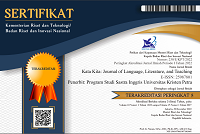A STUDY OF CODE-SWITCHING USED BY AN ENGLISH TEACHER IN TEENAGERS’ EFL CLASS
DOI:
https://doi.org/10.9744/katakita.3.2.27-31Keywords:
perusahaan keluarga, perencanaan suksesi, suksesorAbstract
This study is aimed to analyze the types of code-switching used by the teacher and under what circumstances the switching occur to identify its function. Using qualitative approach, the writer did this study based on code-switching theory of Wardhaugh (2006) and classroom interaction of Walsh (2011). The findings revealed that the teacher used both types of code-switching, intra-sentential and inter-sentential switching. The function of the code-switching identified through the four features of classroom interaction were control of interaction to control the participation, content, procedure of the lesson; speech modification to clarify meaning, to ensure the students’ understanding; elicitation technique to elicit response for checking comprehension; repair to correct error directly or get the students to correct the errors. From this study, it could be concluded that the teacher used code-switching to make the learning process clearer, so the students would not get confused and would not have misunderstanding in the classroom.
References
Liu, J. (2010). Teachers’ Code-Switching to the L1 in EFL Classroom. The Open Applied Linguistics Journal, 3, 10-23.
Walsh, S. (2011). Exploring classroom discourse: language in action. London: Routledge.
Wardhaugh, R. (2006). An introduction to sociolinguistics (5th ed.). Oxford: Basil Blackwell.
Downloads
Issue
Section
License
Authors who publish with this journal agree to the following terms:- Authors retain copyright and grant the journal right of first publication with the work simultaneously licensed under a Creative Commons Attribution License that allows others to share the work with an acknowledgement of the work's authorship and initial publication in this journal.
- Authors are able to enter into separate, additional contractual arrangements for the non-exclusive distribution of the journal's published version of the work (e.g., post it to an institutional repository or publish it in a book), with an acknowledgement of its initial publication in this journal.
- Authors are permitted and encouraged to post their work online (e.g., in institutional repositories or on their website) prior to and during the submission process, as it can lead to productive exchanges, as well as earlier and greater citation of published work (See The Effect of Open Access).














